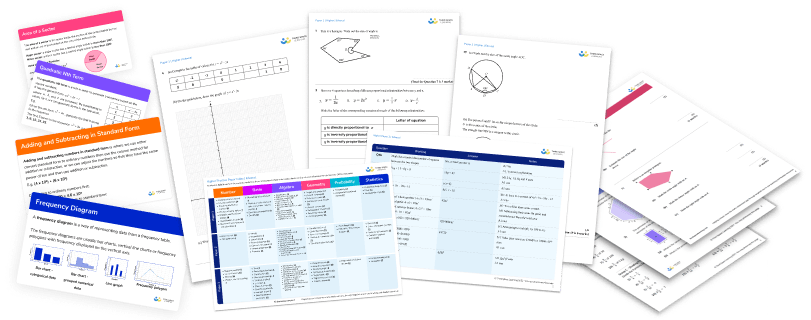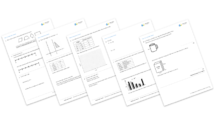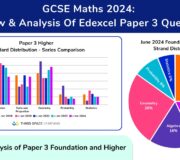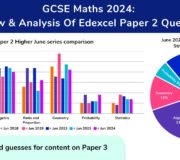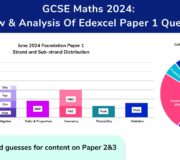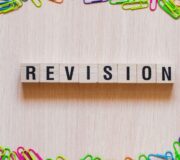Exam Techniques: Making Sure Your Students Make The Most Of Their Marks
Exam techniques and content knowledge are the two fundamental parts of exam preparation. Students need to know the syllabus content and be able to apply it to unfamiliar problems. This knowledge comes from teaching, learning, study skills and revision techniques.
Exam techniques – familiarity with the style of exam question, time management, clear communication and a little bit of clever guesswork – make up the other part of good exam preparation
While content knowledge is definitely the most important part of our job as educators, we also need to have an eye on the exam techniques, and ensure that our young people have the best exam strategies under their belts when they go into the exam, so that they have the best possible opportunity to demonstrate the full range of their knowledge, skills and understanding.
In this blog, I look at things we can do in the classroom to help students nail their exam technique and a few top tips for students to try in the exam to gain every possible mark they can.
Practice Paper Pack: Edexcel Foundation, Advanced Info for Summer Series 2022
Download this free pack of Edexcel Foundation GCSE Maths practice papers to help you revise for exams.
Download Free Now!GCSE MATHS 2024: STAY UP TO DATE
Join our email list to stay up to date with the latest news, revision lists and resources for GCSE maths 2024. We’re analysing each paper during the course of the 2024 GCSEs in order to identify the key topic areas to focus on for your revision.
Thursday 16th May 2024: GCSE Maths Paper 1 2024 Analysis & Revision Topic List
Monday 3rd June 2024: GCSE Maths Paper 2 2024 Analysis & Revision Topic List
Monday 10th June 2024: GCSE Maths Paper 3 2024 Analysis
GCSE 2024 dates
GCSE 2024 results (when published)
GCSE results 2023
During revision sessions
Think like an examiner
As part of the revision technique of completing past papers, it’s good to get students to engage with the examiners’ reports; these provide information on common mistakes and tips for good examination practice. They also comment generally on which topics have been tackled well nationally and which require improvement.
From the Edexcel Chief Examiner’s report for June 2019 (the last whole-cohort exam series before the impacts of the Covid-19 pandemic), we have a few good general exam tips:
- Make sure students have the correct equipment;
- Cross out an error rather than writing over it, as this can make it illegible;
- Make sure any working out done on a calculator is also written down on the exam paper;
- In the case of multiple attempts at the same question, cross through any work that students do not want marked – but don’t scribble or rub out!
I like to use examiners’ reports in class by snipping the relevant section for a question that students may have struggled with on a mock exam or homework past paper and displaying this alongside the question and mark scheme. We can then break down where the struggle has occurred and see what the examiner highlights as issues, so we know what to work on for similar questions in the future.
Read more:
- How To Revise
- How to revise for maths
- Maths Higher Past Papers
- Edexcel Maths Past Papers
- GCSE Maths Questions
- How to reduce exam anxiety
- Revision timetable template
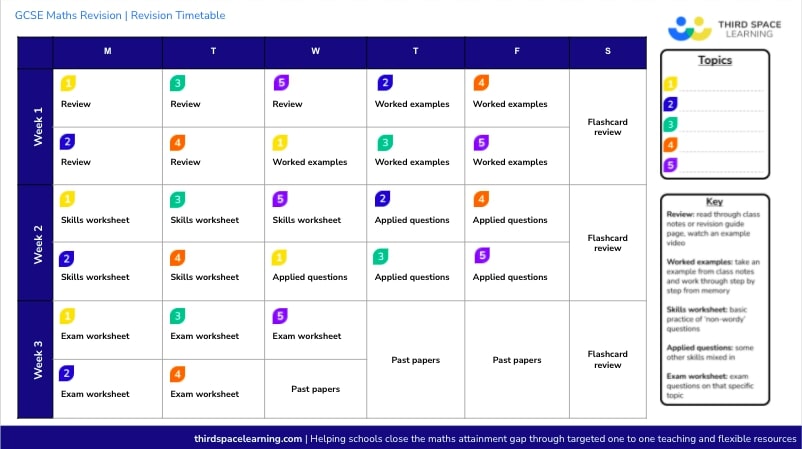
Think about how marks might be allocated on the mark scheme
Getting students to engage with mark schemes when completing past papers is a good way to show them how marks are allocated, and types of marks are available. A few common ones are in the table below:
| M | Method mark for a correct or partial method |
| A | Accuracy mark, awarded after a correct method or process |
| B | Unconditional accuracy mark (no method needed) |
These are common to most major exam boards.
One-mark questions are either marked right or wrong, so students don’t need to spend a lot of time recording their working out for these problems – these are usually B marks. When revising with Year 11, it can be good to incorporate a regular low-stakes quiz on B-mark topics.
Questions worth two marks often have one mark for method and one for accuracy (M1 A1 on a mark scheme). It’s worth mentioning to students that this mark is not for ‘the correct answer’, as they sometimes assume from the ‘A’.
Unless the question states that working must be shown, a fully correct answer with no working will usually get both marks – however, I usually avoid telling students this fact until just before the exam, or at all, if I can get away with it!
Third Space Learning’s online GCSE revision lessons, GCSE revision mats and GCSE maths worksheets all contain practice questions and exam style questions that indicate how many exam marks a question would be worth. Our GCSE maths resources are a good way for students to revise a wide range of topics and get familiar with the types of questions that will appear on the exam.
With our one-to-one online GCSE maths tuition, diagnostic testing is used to identify the gaps in students’ learning and then tailor the revision programme to focus on the types of questions they struggle with. Students are then able to work through these topics step by step with the support of their tutor, gaining confidence before exam day.
See also: How To Revise For GCSE
Peer mark using mark schemes
This is another great method of exam preparation to get students to think about how their answers are presented and how easy it is for someone else to interpret what they’ve written! Rather than marking a whole paper, I’d choose a couple of harder, long-answer questions, such as problem-solving questions requiring applications of multiple topics. Discuss each step of the mark scheme in depth and ask students to critically mark each other’s work.
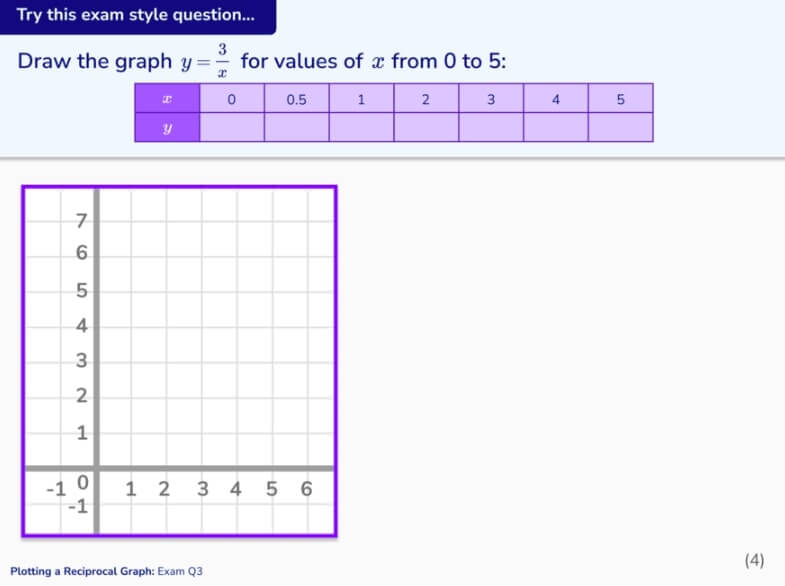
Another way of doing this is to prepare a selection of mocked-up answers to the same question, with different levels of response. Students can then decide how these should be marked in a similar manner – this removes the degree of personal criticism involved in marking each other’s work.
Read more: GCSE Grade Boundaries
Know what to expect on the paper
Non-calculator vs calculator
Each board has one non-calculator paper and two calculator papers. The nature of some questions and topics mean they are more suited to one or the other; ensuring students are aware of these gives them some focus for last minute revision or revision in between papers.
The table below has some suggestions of topics that are more likely to appear on a particular type of paper. Please note though that any topic can be examined on any paper – for example, while fraction addition is more likely to appear on the non-calculator paper, it could also appear on the calculator papers as a ‘show that’ question, or in context, or as an assumed skill for more advanced work.
Non-calculator
- Simplifying fractions
- Leaving answers in terms of 𝜋
- Calculations i.e. four operations with integers and fractions
- Order of operations
- Estimating calculations
Calculator
- Solving using quadratic formula
- Circle theorems
- Iteration
- Sine and cosine rule
- Area of triangle using ½ ab sin C
Other topics which don’t require a calculator, e.g. transformations, constructions, sketching and transforming graphs tend to appear slightly more frequently on the two calculator papers, just because there is less room for them on the non-calculator paper!
Use a to help plan and organise revision sessions and topics.
Before the exam
Eat a decent meal
Try to point students towards slow-release carbohydrates and protein rather than chocolate bars and energy drinks to avoid a sugar crash in the exam. Some schools run a breakfast club before GCSE exams to support students with morning exams. Encourage students to bring a bottle of water to keep hydrated during the exam.
Early morning sessions
Some students find it beneficial to attend an early session immediately prior to a morning exam, but I’d avoid the temptation to use this to cram in some last minute teaching – it’s unlikely to stick in their heads, and might just confuse them and cause additional exam stress.
A better use of this time is to chat through any concerns and calm nerves. If students really want to do some final revision, encourage them to look through flashcards to remind themselves of key formulae – something useful might just stick in their short term memory.
Do a calculator check
If you’re likely to get most of your class in for a short time before an exam, it can be useful to get them to turn their calculators on and reset them – this avoids students going into exams with their calculators inexplicably set in radians rather than degrees, for example.
At the beginning of the exam
Jot down important formulae
If there are formulae that students are likely to forget or muddle up, get them to write these down on the inside front cover (or anywhere there’s blank space they can find easily); this takes the pressure off when they come across the topic on the paper.
You can give students a mnemonic or rhyme to help them remember key formulae – all they need to do is repeat this in their heads as they go into the exam, then write the formulae down as soon as they’re allowed to start writing. This works well on Foundation with circumference and area of a circle: ‘Cherry Pie’s Delicious (C = πD), Apple Pies aRe too (A = πr2).
Before you start writing
Don’t try and read through the whole paper
While this is good practice for some subjects, particularly those where students have a choice of topics to answer, there’s very little gain in scanning through the whole paper in GCSE Maths as all the content has to be attempted.
Some students prefer to look through and find questions on topics they ‘like’ – this might give them a good initial boost, but encourage them to look no further than about halfway (they can use the staples in the middle of the paper as a guide), as harder questions generally appear in the back half of the paper.
Look for command words
A command word tells students how they should answer an exam question.
Here are some useful general ones:
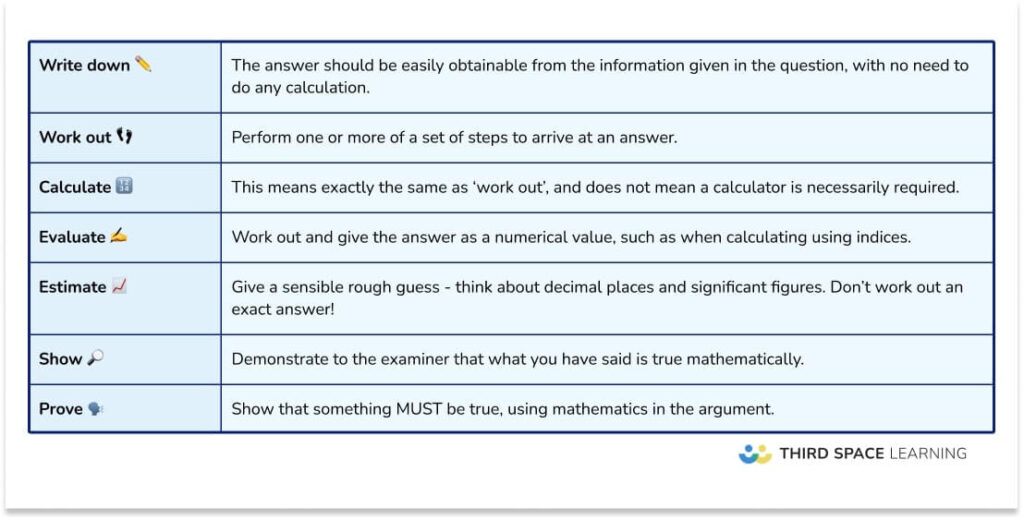
Command words like construct, factorise or reflect indicate to students exactly which knowledge or skill to apply.
When working on past papers with students, it is useful to practise spotting command words in exam questions, getting students to underline or highlight and then discuss what information this gives about the question. For example, ‘evaluate’ means a numerical value is required as an answer – so if the answer they end up with isn’t numerical, it’s a hint that something has gone wrong!
Read the question carefully
A good process for tackling wordier questions is as follows:
- Read the question once, all the way through;
- Identify the command word;
- Read the question again and underline any key points or values.
Sometimes, a useful strategy can be to translate some of the ‘wordy bits’ into ‘maths’ while reading. A problem similar to the example below appeared on the 2020 Higher Paper 1 from Edexcel:
Liquid A and liquid B are mixed to make liquid C.
Liquid A has a density of 60kg/m³ and a mass of 1500kg
Liquid B has a density of 300kg/m³ and a volume of 40m³
Work out the density of liquid C.
Writing d=60 and m=1500 may help students to spot the first step of using a rearrangement of the equation d=mv to calculate the volume.
Showing working out and method marks
Show working out for every question
Generally speaking, I find it best to encourage students to write down a representation of their method for every question – although single-mark questions with B marks have no credit for working, it’s best not to muddy the waters with students and have them second-guessing this in the exam. It is crucial that they show working out for any question worth more than one mark.
Record anything done on a calculator
As already discussed above, a common theme on examiners’ reports is that students often don’t record what they’ve entered into their calculator on the exam paper. This means that, in the case where there’s a transcription error from the calculator screen, students often may not receive any credit for a correct method or process. Generally speaking, anything that’s entered on a calculator screen should also be transcribed onto the paper.
Good timing
Check the number of marks available for each question
Looking at the number of marks available for each exam question is a very useful exam technique for students to help with exam time management and to gauge the expected level of response.
Questions worth one or two marks are unlikely to need a long or complicated response, so if students find they’re spending a lot of time on this type of question, it’s likely they’ve made an error or need to re-read the question to check they’re doing the right thing. Questions with three or more marks need a more detailed response – so if students have answered a four-mark question in one line, it is unlikely they are correct and probably need to check their work again!
Don’t spend too long working on a single question
It’s important to encourage students to move on to the next question if they’ve spent a while on a single question and aren’t making much progress. They can return to these questions at the end of the paper and try these again.
Aim to leave at least ten minutes at the end to check for avoidable errors
Get students into the habit of performing a quick error check, particularly on single-mark questions that are either right or wrong (usually B marks on the mark scheme), and making sure that they leave enough time for this.
What to do if you finish early
Try and attempt every question
If students have left any questions blank, this is a good time to go back and attempt some form of response, even if this is just writing a relevant formula and substituting some numbers, performing a single relevant calculation in a multi-step problem, or having a guess!
For example, returning to the density problem discussed above:
Liquid A and liquid B are mixed to make liquid C.
Liquid A has a density of 60kg/m³ and a mass of 1500kg
Liquid B has a density of 300kg/m³ and a volume of 40m³
Work out the density of liquid C.
This problem is quite complex and students may struggle to see a clear path to a solution. However, one mark out of three was awarded for a single correct use of the density/mass/volume formula for either liquid – and students should be encouraged to scrape every mark like this that they can.
If the exam paper includes multiple choice questions, make sure they’ve not left any of these blank.
Check work carefully
In my experience, the way most students approach this is with a cursory glance over each question. If this is all they have time for, this is better than nothing. Students should be taught to use inverse processes to check their work as common practice – for example, when teaching factorising, it’s useful to get students to check their answer by expanding brackets and, crucially, record this checking process.
Re-do the high-mark questions
If students find that they’re sitting there with more than about fifteen minutes, a good tip is to pick some of the 4-5 mark questions and reattempt them from scratch, without looking at their recorded working out. They can do this in pencil faintly alongside their original question – remind them to cross out any working that they do not want to be marked, or to rub this out once they have finished checking.
Student FAQs about exam techniques
In this section I summarise the key points from this article to answer a few common students FAQs when it comes to exam preparation and techniques:
What are the best exam techniques?
- Look for command words (calculate, show that, evaluate, prove) to indicate what the question requires;
- Read each question carefully before beginning;
- Try and read the question actively, jotting down key information as you do so;
- Check the number of marks available for each question and use this as a guide for timings;
- Don’t spend too long on a question if you’re struggling with it – leave it and return to it later on;
- Demonstrate your method for all questions, particularly on the calculator papers;
- Try and leave enough time at the end to check for errors or to attempt questions you’ve left blank.
How can you improve exam technique?
- Use mark schemes and examiners’ reports to help you ‘think like an examiner’ and work out exactly what’s expected in your answer;
- Practise completing exam papers in timed conditions, including leaving time at the end to check your answers;
- Use information given to you by your teacher, or from the advance information documents, to prepare yourself for topics that will be on the exam, and ensure you’ve revised these thoroughly.
What should you do on exam day?
- Have a good breakfast – slow release carbs and protein rather than high-sugar!
- Have a last-minute check through flashcards if this helps to settle your nerves, but don’t try and learn anything new;
- Check that your calculator is set up correctly – if in doubt, reset it (your manual should tell you how to do this), or ask a teacher to reset it for you;
- Try to remain calm as you go into the exam (this is easier said than done!) – but you have prepared as much as you possibly can by this point, and all that’s left to do now is demonstrate that to the best of your ability.
DO YOU HAVE STUDENTS WHO NEED MORE SUPPORT IN MATHS?
Every week Third Space Learning’s specialist online GCSE maths tutors support thousands of students across hundreds of schools with weekly online 1 to 1 maths lessons designed to plug gaps and boost progress.
Since 2013 these personalised one to one lessons have helped over 150,000 primary and secondary students become more confident, able mathematicians.
Learn about the GCSE revision programme or request a personalised quote for your school to speak to us about your school’s needs and how we can help.
